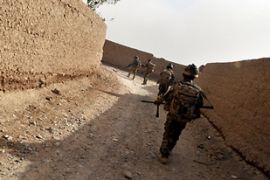Afghan troops ‘overrated’ by US
Audit report casts doubt on $27bn effort to prepare army and police to provide security.

President Obama’s strategy for the war against Taliban fighters centres on transferring responsibility for security to Afghan forces.
He is sending 30,000 more US troops to Afghanistan this year, but wants to start withdrawing them in mid-2011.
The US report on Afghanistan comes as the June toll of foreign soldiers in the country touched the 100 mark.
Big failings
The report by the Special Inspector-General for Afghanistan Reconstruction found big failings in the methods US and multinational forces have used since 2005 to assess the readiness of Afghan army and police who will be left behind.
“We don’t really know at this point in time what the capability of the Afghanistan security forces really is,” Arnold Fields, the chief inspector, said.
The rankings used to grade Afghan forces varied greatly from one region to another, the report said.
| In depth | |||||||||||||||||||||
|
Personnel numbers for the Afghan army were overstated and did not take absenteeism into account.
Afghan forces often backslid even if they did get high marks from their mentors.
“The ANP (Afghan police) will simply stop doing what we asked them to do as soon as we leave the area,” one team mentoring Afghan police complained to auditors.
Recently US officials have focused on the need for more trainers to bolster the Afghan security forces.
The long term goals for the army are 134,000 by October 2010 and 171,000 by
October 2011.
Goals for the police are 109,000 by October 2010 and 134,000 by October 2011.
But the auditors focused on deficiencies in the way progress toward these goals was being monitored.
Fields said coalition commanders recently scrapped their system for ranking Afghan forces and replaced it with a new one after auditors pointed out problems.
The auditors visited 18 Afghan army and police units between October 2009 and May.
“I would be hard pressed to be able to convey to the senior leaders of this country exactly where we are in terms of the training and equipping and the capability of the Afghanistan security forces,” Fields said when asked what he would tell Obama’s new nominee to command US and international forces in Afghanistan, General David Petraeus.
Widespread corruption
So far $27bn has been spent training and equipping Afghan security forces, including the army and police.
Widespread corruption and drug abuse among Afghan security forces as well as logistics nightmares plagued the effort to develop independent Afghan forces, the auditors said.
Trainers were overstretched and sometimes ill-trained themselves.
 |
| Report said trainers are ‘overstretched and sometimes ill-trained themselves’ [AFP] |
Reporting from Kabul, Al Jazeera’s Zeina Khodr said the report “is not good news” and that it “contradicts assessments made by US military commanders that the training mission is on track”.
“We all know that strengthening the capability of the local Afghan forces is the exit strategy – handing security over to them,” she said.
Colonel Stuart Cowen, head of the Nato training mission in Afghanistan, told Al Jazeera, the report by the Special Inspector-General “has made some very valid assertions” to some extent.
“However, those assertions were made on data that is slightly outdated. The Nato training mission in Afghanistan, since the research went into that investigation, has made some radical changes and developed the training,” he said.
“So whilst they were valid assertions, we would say that the whole training mission has moved on significantly since that investigation.”
There were multiple reports of Afghan police skimming fuel, pilfering weapons, and shaking down travellers for money at checkpoints, the report said.
Drug problems
Drug abuse affected 17 per cent of police, according to one Afghan assessment in February that Nato officials thought was low, it said.
Things were so dangerous in some areas, some of the police mentoring had to be carried out over the radio.
Auditors could not visit a police district in the northern Afghan province of Baghlan that received high marks from mentors from August 2008 to June 2009.
 |
| The US report accuses the Afghan police of pilfering weapons and skimming fuel [AFP] |
By February 2010 it was “overrun with insurgents”. Delays in construction projects restricted training too.
Afghan army personnel were housed in temporary facilities at a project in Kunduz province when auditors appeared in February.
“We observed Afghan army personnel coping with deep mud, freezing conditions, unsanitary shower and bathroom facilities, inadequate dining facilities, medically unsafe food storage, and sewage being openly discharged on the surface of the compound,” the report said.
The US and Afghan forces have, however, had some success recently.
A force of about 700 US and Afghan troops have killed up to 150 Taliban fighters in a major offensive along eastern Afghanistan’s border with Pakistan The Washington Post reported on Tuesday.
The US-led operation, which began on Sunday, was one of the largest yet in the region around Kunar province, said the newspaper, which cited US officials as calling it “one of the most intense battles of the past year” in Afghanistan.
